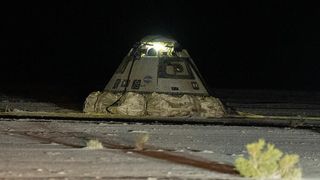
The uncrewed Starliner, which docked with the ISS months ago, touched down in the New Mexico desert, completing a mission critical for the company's testing and validation efforts. This mission comes after years of delays, safety concerns, and technical difficulties, which have pushed Boeing's timeline further than initially expected. The Starliner’s return without astronauts underscores Boeing’s cautious approach in ensuring the spacecraft’s safety before allowing humans onboard.
The decision to delay the crewed mission follows concerns raised over the Starliner's safety systems, particularly with regard to its parachutes and wiring insulation. Engineers discovered flaws during pre-flight checks, which necessitated extensive re-evaluation and repairs. These findings prompted Boeing and NASA to decide that the spacecraft's autonomous return was the best course of action while safety enhancements are implemented.
Boeing has faced mounting pressure to prove its spacecraft's reliability, especially as the company is in direct competition with SpaceX, whose Crew Dragon capsule has already completed several successful crewed missions to the ISS. SpaceX's success has highlighted Boeing’s lag in the Commercial Crew Program, putting the aerospace giant under increased scrutiny. Boeing's delay in flying astronauts aboard the Starliner has been met with frustration, both within NASA and among stakeholders in the space industry.
While NASA and Boeing maintain that ensuring astronaut safety is paramount, the repeated postponements have attracted criticism. Initial projections had pegged Boeing's first crewed flight for 2019, but after a failed test mission that year, a string of issues pushed back the timeline. This uncrewed landing represents a step toward addressing those concerns, but challenges remain as Boeing works toward a crewed flight possibly in 2024.
A significant part of the delay can be attributed to the 2019 test, during which the Starliner failed to reach the ISS due to a software malfunction that caused it to miscalculate its position in space. The mishap prompted a detailed investigation, which revealed multiple technical issues, forcing Boeing to revise its approach and undergo a full redesign of critical systems. It was a humbling experience for the company, which had hoped to demonstrate its capability to safely transport astronauts into space by then.
The Starliner’s most critical challenges involve its parachute system and wiring insulation. The parachutes, vital for ensuring a safe descent and landing, have been a particular focus. Tests conducted earlier indicated inconsistencies in the performance of the parachutes, leading to concerns about their reliability. In addition, engineers discovered problems with the spacecraft's wiring insulation, which was found to be more prone to damage than initially anticipated. Both issues have demanded extensive repairs and re-evaluation to bring the Starliner up to NASA’s rigorous safety standards.
NASA's Commercial Crew Program, which seeks to reduce dependence on Russian Soyuz spacecraft for ferrying astronauts, has been relying heavily on Boeing and SpaceX to meet its objectives. While SpaceX has taken the lead with its Crew Dragon capsule, Boeing's Starliner remains a critical part of NASA’s strategy to create a robust human spaceflight ecosystem. Boeing has continued to receive funding from NASA despite the setbacks, underscoring the agency’s commitment to having multiple partners in the program.
Boeing remains optimistic that, once the technical issues are resolved, the Starliner will become a reliable workhorse for ferrying astronauts to and from space. The company has already secured multiple contracts to provide transportation services for NASA astronauts, but the delays have cast a shadow on Boeing's ability to deliver on these promises in the short term. Nonetheless, industry experts believe that Boeing's vast experience in aerospace engineering and its extensive collaboration with NASA will ultimately result in a successful crewed flight.
As Boeing works through the final stages of testing, the space industry is keeping a close eye on its progress. The Starliner is expected to undergo another uncrewed mission early next year to test the effectiveness of the repairs and ensure that the parachutes and wiring meet all safety requirements. NASA has indicated that once these tests are completed and the spacecraft receives the green light, a crewed mission will follow shortly thereafter.
Topics
World
